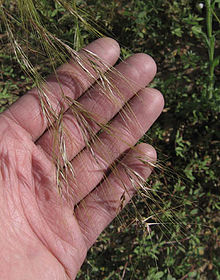Nassella pulchra
| Purple Needlegrass | |
|---|---|

| |
| Scientific classification | |
| Kingdom: | |
| (unranked): | |
| (unranked): | |
| (unranked): | |
| Order: | |
| Family: | |
| Genus: | |
| Species: | N. pulchra
|
| Binomial name | |
| Nassella pulchra | |
| Synonyms | |
Nassella pulchra, basionym Stipa pulchra, is a species of grass known by the common names purple needlegrass and purple tussockgrass.[3] It is native to California, where it occurs throughout the coastal hills, valleys, and mountain ranges, as well as the Sacramento Valley and parts of the Sierra Nevada foothills, and Baja California.
It grows in many types of local habitat, including grassland, chaparral, and oak woodland. It grows well on clay and serpentine soils.[4]
Description
Nassella pulchra is a perennial bunch grass producing tufts of erect, unbranched stems up to 1 metre (3.3 ft) tall. The extensive root system can reach 20 feet (6.1 m) deep into the soil, making the grass more tolerant of drought.[5]
The open, nodding inflorescence is up to 60 centimeters long and has many branches bearing spikelets.
The plant produces copious seed, up to 227 pounds per acre in dense stands.[4] The pointed fruit is purple-tinged when young and has an awn up to 10 centimeters long which is twisted and bent twice.[6][7] The shape of the seed helps it self-bury.[4]
Uses
This grass is the preferred material utilized by the California Indian Basket Weavers for teaching children the art of basket weaving.[8]
State grass
Purple needlegrass became the California State Grass in 2004.[9] It is considered a symbol of the state because it is the most widespread native California grass, it supported Native American groups as well as Mexican ranchers, and it helps suppress invasive plant species and support native oaks.[9] It also helps prevent soil erosion by establishing a large, fibrous root system which holds the soil in place.
See also
References
- ^ N. pulchra was published in Taxon; Official News Bulletin of the International Society for Plant Taxonomy, 39(4): 611. 1990. Utrecht, The Netherlands. "Plant Name Details for Nassella pulchra". IPNI. Retrieved August 25, 2010.
Basionym to Stipa pulchra
- ^ The basionym to N. pulchra, Stipa pulchra, was first described and published in American Journal of Botany, 1915, ii. 301. Lancaster, Penn. "Plant Name Details for Stipa pulchra". IPNI. Retrieved August 25, 2010.
Notes: U.S.A. (Calif.)
- ^ "Nassella pulchra". ITIS.
- ^ a b c US Forest Service Fire Ecology
- ^ California Native Perennial Grasses. Hastings Natural History Reservation.
- ^ Jepson Manual Treatment
- ^ Grass Manual Treatment
- ^ Tolay Lake Park: Natural and Cultural History
- ^ a b California State Grass
External links
- Calflora Database: Stipa pulchra (purple needlegrass)
- Jepson Manual (TJM93) treatment for Nassella pulchra
- Jepson Herbarium: Jepson eFlora (TJM2) Stipa pulchra (purple needlegrass)
- USDA Plants Profile: Nassella pulchra (purple needlegrass)
- Grass Manual Treatment: Nassella pulchra
- Nassella pulchra — U.C. Photo gallery
- Stipa pulchra — U.C. Photo gallery
- Nassella
- Bunchgrasses of North America
- Native grasses of California
- Grasses of Mexico
- Flora of Baja California
- Flora of the Sierra Nevada (U.S.)
- Natural history of the California chaparral and woodlands
- Natural history of the California Coast Ranges
- Natural history of the Central Valley (California)
- Natural history of the Peninsular Ranges
- Natural history of the San Francisco Bay Area
- Natural history of the Santa Monica Mountains
- Natural history of the Transverse Ranges
- Plants described in 1915
- Symbols of California
